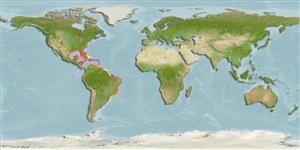>
Holocentriformes (Squirrelfishes, soldierfishes) >
Holocentridae (Squirrelfishes, soldierfishes) > Holocentrinae
Etymology: Sargocentron: Greek, sargos = sargus + Greek, kentron = sting (Ref. 45335).
Environment: milieu / climate zone / depth range / distribution range
Ecologia
marino associati a barriera corallina; distribuzione batimetrica 33 - 110 m (Ref. 35505), usually ? - 82 m (Ref. 37108). Tropical
Western Atlantic: South Carolina (USA), Bermuda, Bahamas, northeastern Gulf of Mexico to Lesser Antilles (Ref. 7251), and southern Brazil (Ref. 47377).
Size / Peso / Age
Maturity: Lm ? range ? - ? cm
Max length : 13.0 cm SL maschio/sesso non determinato; (Ref. 47377); common length : 13.0 cm TL maschio/sesso non determinato; (Ref. 7251)
Spine dorsali (totale) : 11; Raggi dorsali molli (totale) : 11 - 12; Spine anali: 4; Raggi anali molli: 8. Usually ones small black spot present on tip of membrane between 1st and 2nd dorsal spines; nasal without spine (Ref. 13608). Snout spinules small, scales asymmetrical. Ridges on lower half of opercle numerous. Head and body salmon red with six very distinct white stripes (Ref. 37108).
Known from offshore , deep waters, with adults trawled between 33-110 m (Ref. 37108). Intertidal observations were also reported (Ref. 49162).
Life cycle and mating behavior
Maturities | Riproduzione | Spawnings | Egg(s) | Fecundities | Larve
Smith-Vaniz, W.F., B.B. Collette and B.E. Luckhurst, 1999. Fishes of Bermuda: history, zoogeography, annotated checklist, and identification keys. American Society of Ichthyologists and Herpetologists Special Publication No. 4. 424 p. (Ref. 35505)
IUCN Red List Status (Ref. 130435)
Threat to humans
Harmless
Human uses
Strumenti
Special reports
Download XML
Fonti Internet
Estimates based on models
Preferred temperature (Ref.
123201): 19.5 - 27.4, mean 24.7 °C (based on 117 cells).
Phylogenetic diversity index (Ref.
82804): PD
50 = 0.5000 [Uniqueness, from 0.5 = low to 2.0 = high].
Bayesian length-weight: a=0.01622 (0.00774 - 0.03400), b=2.97 (2.80 - 3.14), in cm total length, based on LWR estimates for this Genus-body shape (Ref.
93245).
Trophic level (Ref.
69278): 3.5 ±0.5 se; based on size and trophs of closest relatives
Resilienza (Ref.
120179): Alto, tempo minimo di raddoppiamento della popolazione meno di 15 mesi (Preliminary K or Fecundity.).
Fishing Vulnerability (Ref.
59153): Low vulnerability (10 of 100).
Nutrients (Ref.
124155): Calcium = 83.2 [32.5, 335.8] mg/100g; Iron = 0.626 [0.249, 1.979] mg/100g; Protein = 18.4 [17.2, 19.6] %; Omega3 = 0.176 [0.074, 0.408] g/100g; Selenium = 37.6 [21.3, 74.7] μg/100g; VitaminA = 85.4 [31.9, 240.2] μg/100g; Zinc = 2.29 [0.95, 4.34] mg/100g (wet weight);
